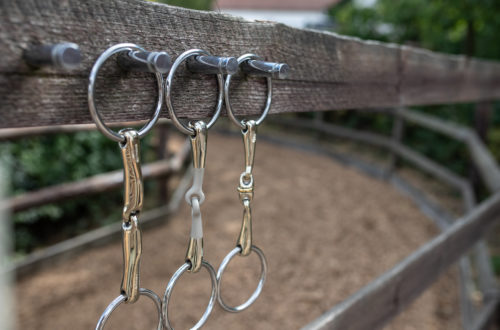
Measure bit - this is how you find the right bit for your horse
Measuring teeth made easy! Are you wondering whether your horse's bit is the right size? Here you can find out how to determine the correct size of the bit.
What it is: Determine the bit width | Determine bit strength | explanatory videos
Bits serve for fine communication between rider and horse. The help should be transferred directly and specifically to the horse's mouth. For this it is necessary that the bit has the right shape and size and is correctly buckled. Since the horse's mouth is very sensitive, this topic should be treated conscientiously and adapted to the individual needs of your horse.
So you determine the bit width
When measuring the width, you must take into account that there is a distance of 5 mm between the tray and the bit ring. Furthermore, the bit must not protrude more than 0,5 cm if it is currently in the mouth.

Bits with fixed side parts
You decide on one Horse bit with fixed side parts (e.g. olive head and D-ring bits or thigh bridles), the bit can be chosen half to whole numbers smaller than with so-called water bridles.

Bits with movable rings
The water Bridles, So Bitten with free moving rings it is important that the jaw angles are not clamped and that the rings always remain freely movable. When lying straight in the horse's mouth, the bit must not protrude more than 0,5 cm (Section 70 of the current LPO).

Double bridles & bridles
Do you ride on? Curb, this should be chosen half to whole number smaller than the corresponding one Underlay bridle. The size of this should be chosen similar to the working bit used.
Determine the bit strength very easily
An important criterion when selecting the bits is their strength. There are also different variants here. The bit strength must always be individually adapted to the horse. The decisive factor here is how much space is available in the horse's mouth. There is a widespread fallacy that horses with large heads need stronger teeth than petite horses. The mouth is actually often smaller and flatter than usual.

THE 2-FINGER TEST
A somewhat imprecise but very helpful method of measuring the required strength is the 2-finger test. To do this, you put your index and middle fingers in the place in the horse's mouth where the bit will be inserted. If you feel pressure on both fingers, the recommended thickness is 14-16 mm. If, on the other hand, you hardly feel any pressure, you can also use a bit with a thickness of 16 - 18 mm.
If you want to know exactly, you can ask your veterinarian for help with the next dental exam.
If you choose a bit that is too thick, it can press very uncomfortably on the sensitive palate and lead to painful pressure points. Unfortunately, this problem is fairly common and can lead to head banging, opening the mouth or "laying on the hand". If your horse shows these symptoms, you should also check the bit strength once.
Helpful videos on measuring teeth





